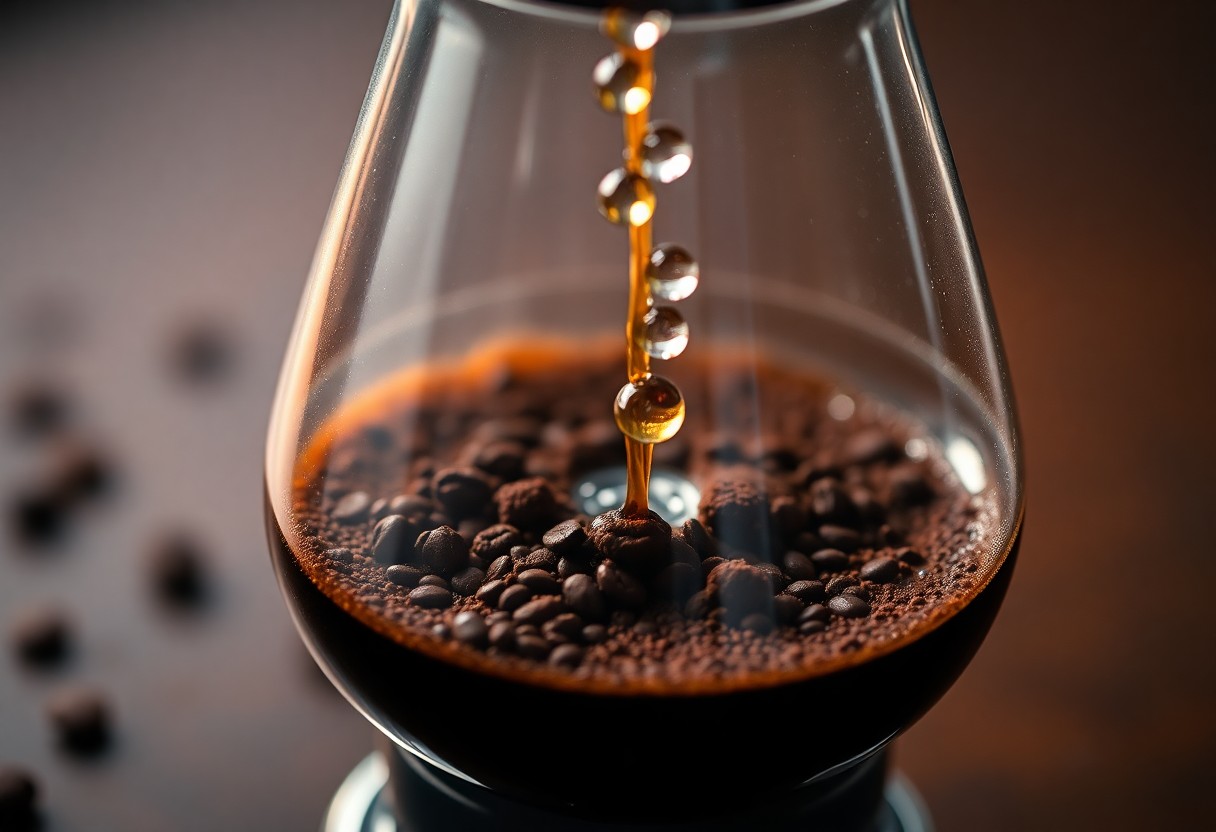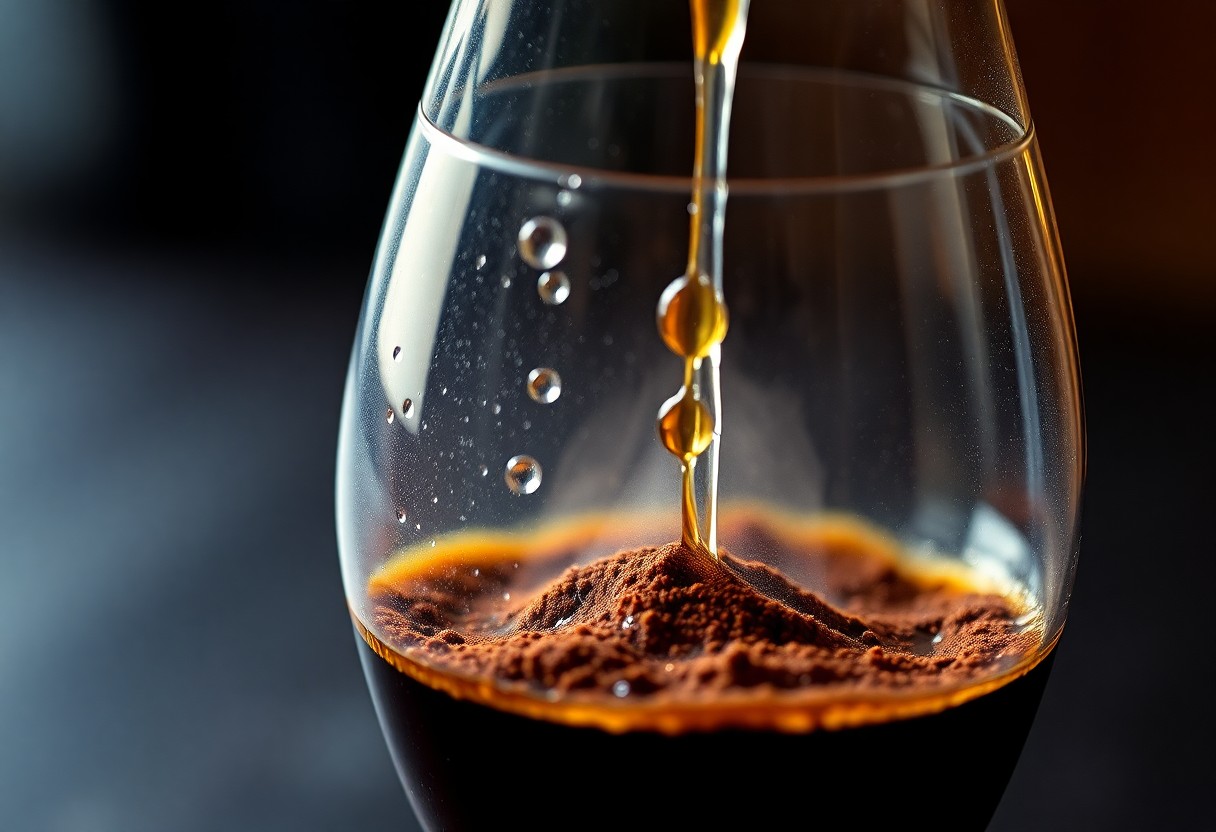There’s a fascinating process happening when you brew coffee, particularly during the initial moments known as blooming. This stage enhances the extraction of flavors from the coffee grounds, resulting in a cup that can drastically vary in taste. If you’ve ever noticed that your coffee seems to evolve in flavor within the first 30 seconds, it’s not a coincidence. Understanding this scientific phenomenon can greatly improve your brewing technique and overall coffee experience, leading to a more aromatic and satisfying cup each time you indulge.

Key Takeaways:
- The initial burst of flavor in coffee occurs due to the release of volatile compounds when brewed, impacting taste perception right away.
- Temperature plays a key role in flavor release, with higher temperatures enhancing the extraction of aromatic compounds during the first moments of tasting.
- Personal palate and smell can significantly influence how quickly and accurately one detects flavors, making the early tasting phase unique for each individual.
The Chemical Dynamics of Brewing
Brewing coffee is more than just a simple process; it’s a complex interaction of chemistry and temperature, where each variable alters the extracted flavors. Every component—from the coffee bean to water—plays a vital role in shaping your cup. Understanding how these elements react during brewing can transform your coffee experience, enhancing both the aroma and taste.
The Role of Temperature on Flavor Extraction
| Low Temperatures (below 90°C) | Results in under-extraction, leading to sour and tangy notes. |
| Optimal Temperatures (90-96°C) | Facilitates balanced extraction, emphasizing sweetness and acidity. |
| High Temperatures (above 96°C) | Increases bitterness and can mask delicate flavors. |
Key Compounds Released in the Initial Moments
During the first moments of brewing, specific volatile compounds are released that significantly influence the coffee’s flavor profile. The initial 30 seconds are filled with aromatic oils and acids that impart vibrant notes. For instance, compounds such as caffeine, lipids, and various acids come to the forefront, creating the signature characteristics you notice early on.
The first phrases of extraction unleash a symphony of flavors, primarily because of the volatile nature of these compounds. For example, caffeine provides an initial lift, while oils contribute to the mouthfeel, creating a pleasant tactile sensation. Meanwhile, acids like citric and malic can enhance brightness and complexity, elevating your coffee experience right from the start. Thus, appreciating these fleeting moments can deepen your connection to each cup of coffee you brew.
The Sensory Experience: Taste and Aroma
Your sensory experience of coffee transcends mere taste; it’s a complex interplay of aroma and flavor. The moment you take a sip, your brain engages multiple pathways, processing taste through your taste buds while simultaneously perceiving aroma through your olfactory system. This creates a multi-layered flavor profile that evolves as you sip, with the initial 30 seconds presenting the coffee’s most vibrant notes. As volatile compounds dissipate, the coffee’s character begins to shift, unveiling a less intense but intriguing flavor profile.
How Olfactory Perception Shapes Flavor Profiles
Aromas significantly enhance your perception of flavor, making olfactory input integral to your overall tasting experience. Studies indicate that up to 80% of what you perceive as flavor comes from smell. When you sip coffee, the aromas travel to your olfactory receptors, allowing you to discern the rich notes of chocolate, fruit, or nuts. Thus, the initial bloom in coffee is not just about taste; it’s an invitation for your nose to engage in the flavor journey.
The Impact of Volatile Compounds in Coffee
Volatile compounds play a pivotal role in shaping your coffee drinking experience, particularly in the first moments after brewing. These compounds, which include esters, aldehydes, and phenols, are released during brewing and are responsible for the aromatic profile of your cup. As the coffee cools, these compounds dissipate, which can significantly alter the perceived flavor. For instance, fresh coffee can present vibrant fruity notes that become muted over time, with deeper, more subdued flavors taking precedence as the temperature decreases.
Research shows that there are over 800 volatile compounds in coffee, which contribute to its complex flavor profiles. Notably, compounds like 2-furfurylthiol provide delightful caramel notes, while certain acids generate bright, fruity flavors. The interaction of these compounds creates a specific bouquet that defines your coffee. During the first 30 seconds, the balance of these volatiles is crucial; they are most potent in that time frame, delivering those exciting and intricate flavors that can sometimes seem fleeting. It’s in these precious first moments that your taste buds and olfactory senses work together to create a truly unforgettable coffee experience.
The Blooming Phase: A Critical Moment
Your brewing ritual culminates during the blooming phase, a brief yet transformative moment. This stage occurs just after you pour water over your coffee grounds. You may observe the coffee releasing gases, creating bubbles and a frothy surface. This initial reaction is vital as it sets the stage for optimal extraction, ensuring a more flavorful cup that resonates with your palate long after the initial taste.
The Science Behind the Pre-Infusion Process
The blooming process, often termed pre-infusion, initiates the release of carbon dioxide trapped within freshly roasted beans. This CO2, as it escapes, allows water to interact more effectively with the coffee grounds. By letting your coffee bloom for 30-45 seconds, you promote uniform saturation, ensuring that flavors are evenly extracted, leading to a more balanced and aromatic coffee experience.
How Blooming Affects Acidity, Sweetness, and Body
Your coffee’s flavor profile can significantly shift due to the blooming process, impacting acidity, sweetness, and body. When you allow adequate blooming time, the volatile compounds within the grounds dissolve better into the brew, resulting in a smooth balance of acidity and sweetness, rich in texture and depth.
A well-executed blooming phase minimizes sharp bitterness while enhancing the perceived sweetness of your coffee. The sweet notes come forward as the soluble oils and sugars dissolve more thoroughly, giving rise to an overall smoother cup. Conversely, skipping the blooming process may yield a more acidic and less flavorful brew, as vital compounds fail to extract properly. Notably, many coffee aficionados stress that the blooming phase is what separates an average cup from a truly exceptional one, leading to a rich mouthfeel and lingering finish that defines great coffee.

The Art of Brewing: Techniques to Enhance Flavor
Elevating your coffee experience hinges on the various brewing techniques you employ. The right method can amplify the flavor profile, ensuring that every sip is as delightful as the first. Whether you prefer a pour-over, French press, or espresso, attention to detail in your brewing process can unveil complex flavors hidden within the coffee beans. From water temperature to grind size, every parameter plays a pivotal role in crafting your perfect cup.
Tips for Maximizing Blooming for Optimal Taste
Achieving peak flavor through blooming is centered on a few simple practices:
- Use fresh, coarsely ground coffee beans for optimal blooming.
- Heat your water to about 200°F (93°C) for ideal saturation.
- Wet your grounds evenly, allowing them to bloom for about 30 seconds before proceeding.
- Experiment with your coffee-to-water ratio for personalized results.
Assume that incorporating these tips will transform your brewing routine and unlock the full potential of your coffee.
Common Mistakes to Avoid During Brewing
Small errors during the brewing process can dampen your coffee flavor significantly. Failing to use filtered water can introduce unwanted impurities, while inconsistent grind sizes often lead to uneven extraction. Allowing your coffee to bloom for too long can be detrimental, leading to over-extraction and bitterness. Managing your brew time improperly can also have negative impacts, as too short or excessively long steeping can alter desired flavors.
The nuances of brewing coffee reveal many pitfalls that cultivators often overlook. Neglecting to measure coffee precisely can distort flavor dynamics, causing bitterness or blandness. Additionally, using water that is either too hot or too cold directly impacts extraction; the correct temperature is vital for dissolving the right oils and sugars from your beans. Paying close attention to the blooming phase can be easily overlooked, yet it plays a significant role in the beginning of this process. By avoiding these mistakes, you set the stage for a cup of coffee that showcases the depth and richness that your beans truly possess.
Shifting Perspectives: Rethinking Your Coffee Ritual
Transforming your coffee ritual requires a shift in how you perceive flavor and experience in those initial moments. Instead of viewing coffee as a mere caffeine delivery system, consider it a sensory journey. You can savor the intricate details that contribute to its character, whether it’s the aroma, flavor notes, or the feeling it evokes. This newfound appreciation for the subtleties of your coffee will not only enhance your enjoyment but also enrich your daily routine.
Embracing the Importance of the First 30 Seconds
The first 30 seconds after brewing are often the most illuminating for your palate. During this fleeting moment, volatile compounds that contribute to aroma and taste are at their peak. Your taste buds are finely attuned and ready to fully engage with the coffee’s flavors. Focusing on these first moments allows you to develop a deeper connection to your brew, revealing layers of complexity that may otherwise go unnoticed.
How to Cultivate a Mindful Coffee Experience
To enhance your coffee experience, practicing mindfulness is key. Begin by dedicating a few moments to engage fully with your coffee. Notice the color, and texture, and take in the aroma deeply. When you sip, do so intentionally and with appreciation, allowing your taste buds to explore the various notes. This conscious approach transforms the act of drinking coffee into a ritual of self-care that can invigorate both your body and mind. The tangible benefits of a mindful coffee break can lead to improved focus, reduced stress, and a more profound appreciation for each cup you create.
To wrap up
The science of blooming demonstrates how your coffee’s flavor can significantly differ within the first 30 seconds after brewing. By allowing the gases to escape and the coffee grounds to release their full potential, you enhance the aroma and taste profile of your brew. Understanding this process helps you appreciate the nuances in your coffee, giving you a richer and more enjoyable experience. Next time you brew your favorite cup, take a moment to notice those first flavors that emerge during blooming—they’re an imperative part of what makes your coffee special.
FAQ
Q: What is blooming in coffee brewing?
A: Blooming is the initial stage of brewing coffee where hot water is added to the coffee grounds, causing them to release carbon dioxide. This process creates bubbles and allows for a more even extraction of flavors. The first few moments of blooming are vital as they help to enhance the overall taste of the coffee by allowing the grounds to expand and degas properly.
Q: Why does coffee taste different in the first 30 seconds after brewing?
A: During the first 30 seconds after brewing, the coffee is still in the blooming phase. The flavor profile changes as various compounds are released from the coffee grounds. The first sips can have a brighter and more vibrant taste due to the aromatic oils and acids being more volatile at higher temperatures before they start to mellow out as the coffee cools down.
Q: How does brewing temperature affect the blooming process?
A: Brewing temperature plays a significant role in the blooming of coffee. Water that is too hot can cause over-extraction, leading to bitterness, while water that is too cool may result in under-extraction, making the coffee taste flat. Ideally, a temperature range of 195°F to 205°F promotes the best blooming effect, maximizing flavor release during the initial moments of brewing.
Q: Is the bloom time the same for all types of coffee?
A: No, the bloom time can vary based on the coffee type and grind size. Generally, a bloom time of 30 seconds is recommended for most brewing methods. However, lighter roasts or coarser grinds may require a slightly longer bloom time to fully release the carbon dioxide, while finer grinds may bloom more rapidly. Adjusting the bloom time can help achieve a balanced flavor extraction.
Q: How can I improve the blooming process for better coffee flavor?
A: To enhance the blooming process, use freshly roasted coffee beans and grind them just before brewing, as this preserves the volatile compounds. When pouring hot water over the grounds, start with a small amount to allow the coffee to saturate evenly, and then continue adding water. Experimenting with different bloom times and grind sizes can also help you find the optimal combination for your preferred taste.
